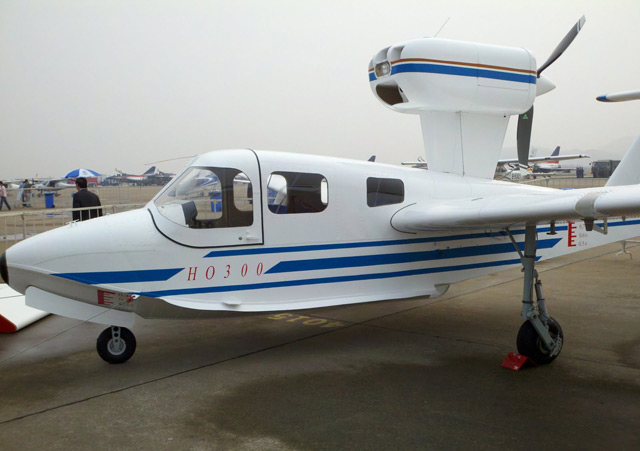Despite some promising signs, China is still wary about embracing general aviation. This makes any kind of progress a significant challenge.
A representative from a Western light aircraft maker recently told Flight International about the difficulty of finding a qualified distributor for his firm's aircraft in China. The issue is not the lack of interest, but an overwhelming response from dozens of companies and individuals, the vast majority with negligible knowledge about the issues surrounding the marketing and operating of light aircraft. However, all promised government and business connections that would ensure strong sales when China's market takes off.
 |
|---|
Greg Waldron/Flightglobal AVIC displayed an indigenously developed seaplane in 2010, hinting at the county's potential |
In relation to China's airspace liberation, the word "when" is key. For years China has hinted about opening lower airspace, but the People's Liberation Army still jealously guards access to China's airspace. While a major leadership change is set to happen in Beijing later this year, the situation is unlikely to improve soon. Although industry observers note the scattered signs of easing restrictions in selected zones within the country, the airspace below 10,000ft (3,000m) remains firmly in lockdown mode.
"How far and fast the skies are opening will likely be linked to political stabilities of the country," says Jane Zhang, co-founder and president of Silk Wings Aviation, a consulting firm. "In certain areas and provinces of China, we have seen military branches that are more open, progressive and working closely with the Civil Aviation Administration of China, local government and private/state-owned enterprises. But overall, the schedule and agenda for [further opening the skies] remain unclear."
The PLA's stranglehold on airspace makes applying for and receiving flight clearance a torturous process. One pilot tells the story of flying a single-engined turboprop to a small air show at one of China's regional airports. Dealing with the government to obtain a permit for the trip was extremely challenging. When he finally left the airport at the end of the show, no flights were allowed 30min before or after his departure.
"We've heard a lot of announcements of about opening lower airspace in China, but until now, it's in recurring five-year plans," says the pilot. "But there has been no publication of new regulations that stipulate a total opening of airspace."
The key experimental pockets are located in China's progressive Guangdong province near Hong Kong and in the country's northeast region. Small operators are allowed to fly in small boxes, but restrictions are heavy.
Nonetheless, Western airframers are looking for ways to develop their brands and presence in China. In May 2012, Cessna entered an agreement to set up a joint venture with China Aviation Industry General Aircraft, a unit of Aviation Industry Corporation of China, and the Shijiazhuang municipal government to perform final assembly, sales and customer support for the Caravan aircraft in China.
"Not only does this continue Cessna's involvement in the development of general aviation in China, it also paves the way for aircraft sales to which we would not have otherwise had access," says Mike Shih, vice-president for China strategy and business development at Cessna. "These Cessna aircraft will be manufactured in the USA, in Kansas and sent to Shijiazhuang, China, to undergo final assembly and then be sold in China."
"It's going to take a long time before you see something resembling what we have in the USA," says Peter Claeys, who formerly worked for Cirrus in China. "This is not the kind of freedom the government is ready to give to the larger public - and it's uncertain it will ever be ready."
Yong Qiu, managing director at Three Oaks Aviation Consultancy is optimistic, however. He feels that the opening of experimental zones in Guangdong and other locations is a positive development, and hopes for major progress within the next decade.
"It will take quite a few years for the military, which still feels under threat of foreign counterparts, to agree to open up the airspace in a significant amount of provinces," he says. "Hopefully, it will happen in this decade."
Nonetheless, he feels the military's intransigence is not the only challenge facing the development of general aviation in China. He notes that tariffs and taxes on imported aircraft can reach as high as 25% of the aircraft's value, which could deter buyers. Flight permits and a shortage of qualified flight instructors are other problems that also need to be resolved.
Source: Flight International
















